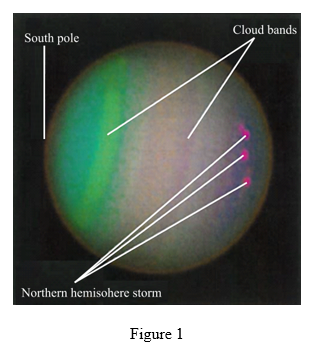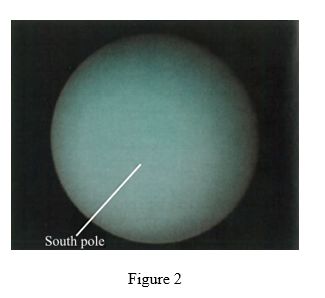
Universe
11th Edition
ISBN: 9781319039448
Author: Robert Geller, Roger Freedman, William J. Kaufmann
Publisher: W. H. Freeman
expand_more
expand_more
format_list_bulleted
Question
Chapter 14, Problem 9Q
To determine
How can one account for the differences as shown in two figures. Given that a number of storms is shown in figure 1 and no storm is visible in figure 2.


Expert Solution & Answer
Want to see the full answer?
Check out a sample textbook solution
Students have asked these similar questions
A 75.0-kg person drops from rest a distance of 1.20 m to a platform of negligible mass supported by an ideal stiff spring of negligible mass. The platform drops 6.00 cm before the person comes to rest. What is the spring constant of the spring?
Please do on paper and show all equations and work done to get to the final answer. Along with any helpful diagrams if needed. These are a part of my review questions in the book but i keep getting different answers from what the book says, it is not a graded assignment***
Problem Ten. A uniform rod is suspended in mechanical
equilibrium by two strings. If T₁ = 500 N, what is the weight of
the rod (in N)?
18.) (A) 120 N
(D) 600 N
(B) 900 N
(C) 500 N
(E) 220 N
T
T
Mg
STAY C
In the figure, two boxes, each of mass 35 kg, are at rest and connected as shown. The coefficient of kinetic friction between the inclined surface and the box is 0.38. Find the speed of the boxes just after they have moved 5.5 m.
Please do on paper and show all formulas and work done to get final answer
This is a review problem , I just keep getting the wrong thing from what the textbook says , so i would like to see the work done
Chapter 14 Solutions
Universe
Ch. 14 - Prob. 1CCCh. 14 - Prob. 2CCCh. 14 - Prob. 3CCCh. 14 - Prob. 4CCCh. 14 - Prob. 5CCCh. 14 - Prob. 6CCCh. 14 - Prob. 7CCCh. 14 - Prob. 8CCCh. 14 - Prob. 9CCCh. 14 - Prob. 10CC
Ch. 14 - Prob. 11CCCh. 14 - Prob. 1QCh. 14 - Prob. 2QCh. 14 - Prob. 3QCh. 14 - Prob. 4QCh. 14 - Prob. 5QCh. 14 - Prob. 6QCh. 14 - Prob. 7QCh. 14 - Prob. 8QCh. 14 - Prob. 9QCh. 14 - Prob. 10QCh. 14 - Prob. 11QCh. 14 - Prob. 12QCh. 14 - Prob. 13QCh. 14 - Prob. 14QCh. 14 - Prob. 15QCh. 14 - Prob. 16QCh. 14 - Prob. 17QCh. 14 - Prob. 18QCh. 14 - Prob. 19QCh. 14 - Prob. 20QCh. 14 - Prob. 21QCh. 14 - Prob. 22QCh. 14 - Prob. 23QCh. 14 - Prob. 24QCh. 14 - Prob. 25QCh. 14 - Prob. 26QCh. 14 - Prob. 27QCh. 14 - Prob. 28QCh. 14 - Prob. 29QCh. 14 - Prob. 30QCh. 14 - Prob. 31QCh. 14 - Prob. 32QCh. 14 - Prob. 34QCh. 14 - Prob. 35QCh. 14 - Prob. 36QCh. 14 - Prob. 37QCh. 14 - Prob. 38QCh. 14 - Prob. 39QCh. 14 - Prob. 40QCh. 14 - Prob. 41QCh. 14 - Prob. 42QCh. 14 - Prob. 43QCh. 14 - Prob. 44QCh. 14 - Prob. 45QCh. 14 - Prob. 46QCh. 14 - Prob. 48QCh. 14 - Prob. 49QCh. 14 - Prob. 50QCh. 14 - Prob. 51QCh. 14 - Prob. 52QCh. 14 - Prob. 53QCh. 14 - Prob. 54QCh. 14 - Prob. 55QCh. 14 - Prob. 56QCh. 14 - Prob. 57QCh. 14 - Prob. 58QCh. 14 - Prob. 59Q
Knowledge Booster
Learn more about
Need a deep-dive on the concept behind this application? Look no further. Learn more about this topic, physics and related others by exploring similar questions and additional content below.Similar questions
- A 64.0-kg skier starting from rest travels 200.0 m down a hill that has a 30.0° slope and a uniform surface. When the skier reaches the bottom of the hill, her speed is 30.0 m/s. How much work is done by friction as the skier comes down the hill? Please do on paper and show all the equations and work done to get to the final answer.arrow_forwardA 550-kg car moving at 18.5 m/s hits from behind a 560-kg car moving at 11.8 m/s in the same direction. If the new speed of the heavier car is 16.0 m/s, what is the speed of the lighter car after the collision, assuming that any unbalanced forces on the system are negligibly small? Please do on paper and show all equations and work done to get to the final answer. Along with any helpful diagrams if needed. These are a part of my review questions in the book but i keep getting different answers from what the book says, it is not a graded assignment***arrow_forwardA 150kg piano rolls down a 30° incline. A man tries to keep it from accelerating, and manages to keep its acceleration to 1.4 m/s^2 . If the piano rolls 8 m, what is the net work, in joules, done on it by all the forces acting on it? Please do it on paper and show all formulas and work used to get the answerarrow_forward
- The rectangular loop of wire shown in the figure (Figure 1) has a mass of 0.18 g per centimeter of length and is pivoted about side ab on a frictionless axis. The current in the wire is 8.5 A in the direction shown. Find the magnitude of the magnetic field parallel to the y-axis that will cause the loop to swing up until its plane makes an angle of 30.0 ∘ with the yz-plane. The answer is .028 T, I just need help understanding how to do it. Please show all steps.arrow_forwardA ray of light from an object you want to look at strikes a mirror so that the light ray makes a 32 degree angle relative to the normal line (a line perpendicular to the surface of the mirror at the point where the ray strikes the mirror). If you want to see the object in the mirror, what angle does your line of sight need to make relative to the normal line? Give your answer as the number of degrees.arrow_forwardSuppose you have a converging lens with a focal length of 65 cm. You hold this lens 120 cm away from a candle. How far behind the lens should you place a notecard if you want to form a clear image of the candle, on the card? Give your answer as the number of centimeters.arrow_forward
- Suppose you have a diverging lens with a focal length of - 25 cm. You look through this lens at a sleeping squirrel, and notice that it forms a virtual image of the squirrel with di = - 18 cm. How far away from the lens is the squirrel? Give your answer as the number of centimeters (a positive number).arrow_forwardDiamond has an index of refraction of about 2.4. Suppose you cut a diamond so it has a flat surface, and shine a laser pointer beam so that it makes a 27 degree angle with respect to the normal line to that surface. What angle will the laser beam make with respect to the normal after it passes through the air-diamond boundary and is inside the diamond? Give your answer as the number of degrees.arrow_forwardFind current of each line of D,E, and F. Where V1 is 9V, V2 is 7V, R1 is 989 , R2 is 2160, R3 is 4630 , R4 is 5530, R5 is 6720, and E is 16V. Please explain all steps. Thank youarrow_forward
- You are tasked with designing a parallel-plate capacitor using two square metal plates, eachwith an area of 0.5 m², separated by a 0.1 mm thick layer of air. However, to increase the capacitance,you decide to insert a dielectric material with a dielectric constant κ = 3.0 between the plates. Describewhat happens (and why) to the E field between the plates when the dielectric is added in place of theair.arrow_forwardCalculate the work required to assemble a uniform charge Q on a thin spherical shell of radiusR. Start with no charge and add infinitesimal charges dq until the total charge reaches Q, assuming thecharge is always evenly distributed over the shell’s surface. Show all steps.arrow_forwardRod AB is fixed to a smooth collar D, which slides freely along the vertical guide shown in (Figure 1). Point C is located just to the left of the concentrated load P = 70 lb. Suppose that w= 17 lb/ft. Follow the sign convention. Part A Figure 3 ft -1.5 ft √30° 1 of 1 Determine the normal force at point C. Express your answer in pounds to three significant figures. ΜΕ ΑΣΦ Η vec Nc= Submit Request Answer Part B Determine the shear force at point C. Express your answer in pounds to three significant figures. VC= ΜΕ ΑΣΦΗ vec Submit Request Answer Part C Determine the moment at point C. Express your answer in pound-feet to three significant figures. Mc= Ο ΑΣΦ Η vec Submit Request Answer Provide Feedback ? ? lb lb ? lb-ftarrow_forward
arrow_back_ios
SEE MORE QUESTIONS
arrow_forward_ios
Recommended textbooks for you

 AstronomyPhysicsISBN:9781938168284Author:Andrew Fraknoi; David Morrison; Sidney C. WolffPublisher:OpenStax
AstronomyPhysicsISBN:9781938168284Author:Andrew Fraknoi; David Morrison; Sidney C. WolffPublisher:OpenStax An Introduction to Physical SciencePhysicsISBN:9781305079137Author:James Shipman, Jerry D. Wilson, Charles A. Higgins, Omar TorresPublisher:Cengage Learning
An Introduction to Physical SciencePhysicsISBN:9781305079137Author:James Shipman, Jerry D. Wilson, Charles A. Higgins, Omar TorresPublisher:Cengage Learning Foundations of Astronomy (MindTap Course List)PhysicsISBN:9781337399920Author:Michael A. Seeds, Dana BackmanPublisher:Cengage Learning
Foundations of Astronomy (MindTap Course List)PhysicsISBN:9781337399920Author:Michael A. Seeds, Dana BackmanPublisher:Cengage Learning
 Horizons: Exploring the Universe (MindTap Course ...PhysicsISBN:9781305960961Author:Michael A. Seeds, Dana BackmanPublisher:Cengage Learning
Horizons: Exploring the Universe (MindTap Course ...PhysicsISBN:9781305960961Author:Michael A. Seeds, Dana BackmanPublisher:Cengage Learning


Astronomy
Physics
ISBN:9781938168284
Author:Andrew Fraknoi; David Morrison; Sidney C. Wolff
Publisher:OpenStax

An Introduction to Physical Science
Physics
ISBN:9781305079137
Author:James Shipman, Jerry D. Wilson, Charles A. Higgins, Omar Torres
Publisher:Cengage Learning

Foundations of Astronomy (MindTap Course List)
Physics
ISBN:9781337399920
Author:Michael A. Seeds, Dana Backman
Publisher:Cengage Learning


Horizons: Exploring the Universe (MindTap Course ...
Physics
ISBN:9781305960961
Author:Michael A. Seeds, Dana Backman
Publisher:Cengage Learning
Kepler's Three Laws Explained; Author: PhysicsHigh;https://www.youtube.com/watch?v=kyR6EO_RMKE;License: Standard YouTube License, CC-BY